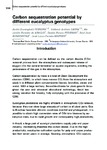Please use this identifier to cite or link to this item:
http://www.alice.cnptia.embrapa.br/alice/handle/doc/1061960Full metadata record
| DC Field | Value | Language |
|---|---|---|
| dc.contributor.author | FERREIRA, A. D. | pt_BR |
| dc.contributor.author | LAURA, V. A. | pt_BR |
| dc.contributor.author | ARAUJO, A. R. de | pt_BR |
| dc.contributor.author | PEDRINHO, D. R. | pt_BR |
| dc.contributor.author | BUNGENSTAB, D. J. | pt_BR |
| dc.contributor.author | MARTINS, J. L. F. | pt_BR |
| dc.date.accessioned | 2017-01-26T11:11:11Z | pt_BR |
| dc.date.available | 2017-01-26T11:11:11Z | pt_BR |
| dc.date.created | 2017-01-26 | pt_BR |
| dc.date.issued | 2016 | pt_BR |
| dc.identifier.citation | In: INTERNATIONAL SYMPOSIUM ON GREENHOUSE GASES IN AGRICULTURE, 2., 2016, Campo Grande, MS. Proceedings... Brasília, DF: Embrapa, 2016. p. 187-190. (Embrapa Gado de Corte. Documentos, 216). Coordenador: Roberto Giolo de Almeida. II SIGEE. | pt_BR |
| dc.identifier.uri | http://www.alice.cnptia.embrapa.br/alice/handle/doc/1061960 | pt_BR |
| dc.description | Carbon sequestration can be defined as the carbon dioxide (CO2) removal process from the atmosphere and subsequent release ofoxygen (O2) for several terrestrial or aquatic organisms, avoiding the permanence of this gas in the atmosphere. Carbon sequestration by trees is a kind of Clean Development Mechanism (CDM), in which trees remove CO2 from the atmosphere and stock it in different plant compartments (leaves, branches, stems and roots). With a large territory, favorable climate for plant growth throughout the year and advanced silvicultural technology, Brazil has strong vocation for forestry, fully complying with the provisions of the CDM. Eucalyptus plantations are highly efficient in atmospheric CO2 removal, because they can store large amounts of carbon in all plant parts. Due to Brazilian favorable climatic conditions (rainfall and photoperiod), it is possible to obtain high conversion rates of CO2 into biomass by eucalyptus trees, due to rapid growth and consequently high productivity. | pt_BR |
| dc.language.iso | eng | eng |
| dc.rights | openAccess | eng |
| dc.title | Carbon sequestration potential by different eucalyptus genotypes. | pt_BR |
| dc.type | Artigo em anais e proceedings | pt_BR |
| dc.date.updated | 2017-03-03T11:11:11Z | pt_BR |
| dc.subject.thesagro | Dióxido de carbono | pt_BR |
| dc.subject.thesagro | Oxigênio | pt_BR |
| dc.subject.thesagro | Organismo aquático | pt_BR |
| dc.subject.thesagro | Eucalipto | pt_BR |
| dc.subject.nalthesaurus | Carbon sequestration | pt_BR |
| dc.subject.nalthesaurus | Carbon dioxide | pt_BR |
| dc.subject.nalthesaurus | Aquatic organisms | pt_BR |
| dc.subject.nalthesaurus | Eucalyptus | pt_BR |
| dc.format.extent2 | p. 338-342 | pt_BR |
| riaa.ainfo.id | 1061960 | pt_BR |
| riaa.ainfo.lastupdate | 2017-03-03 | pt_BR |
| dc.contributor.institution | ANDRE DOMINGHETTI FERREIRA, CNPGC; VALDEMIR ANTONIO LAURA, CNPGC; ALEXANDRE ROMEIRO DE ARAUJO, CNPGC; DENISE RENATA PEDRINHO, UNIDERP; DAVI JOSE BUNGENSTAB, CNPGC; JOSÉ LUCAS FERREIRA MARTINS, UNIDERP. | pt_BR |
| Appears in Collections: | Artigo em anais de congresso (CNPGC)  | |
Files in This Item:
| File | Description | Size | Format | |
|---|---|---|---|---|
| Carbonsequestrationpotential.pdf | 631,56 kB | Adobe PDF |  View/Open |









